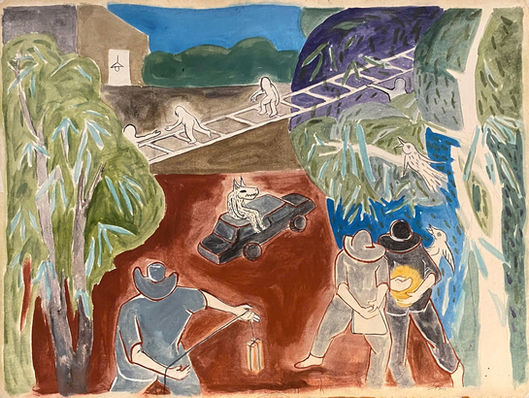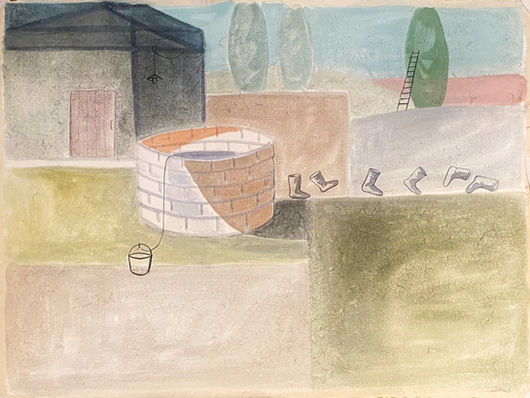
following the stone wall and we found an electric generator
-
July 13, 2025
June 13, 2025
Lê Đình Chung
Opening party: 06.30 PM Friday 13 June, 2025
On display: 11.00 AM - 07.00 PM Tue - Sun | from 14 June until 13 July 2025
Manzi Exhibition Space, 2 ngõ Hàng Bún, Ba Đình
Free entrance
>>> CLICK HERE FOR THE FULL CATALOGUE
***
This special summer show at Manzi acts as a prelude to Lê Đ.Chunh’s ongoing multimedia art project, which began in 2017. The project is a long-term research into a resettled migrant community in what was known as a New Economic Zone during the Đổi Mới era (from the mid-1980s to the early 1990s), specifically in Di Linh, Lâm Đồng.
The occupants were part of a state-enforced resettlement program, a large-scale postwar operation that relocated people from lowland and urban areas to the highland & mountainous areas, and border regions. This program was an effort of the Vietnamese government to redistribute the population and reconstruct the nation’s economy after decades of strife.
Over there, life was forcibly re-established atop the lingering ruins of the colonial period: abandoned plantations were converted into state-run farms; houses were erected on the remains of derelict tea factories; and running alongside a stone wall—the leftover irrigation structures on small streams were reused to power rudimentary generators. These acts of appropriation, though obvious and necessary for survival, carried with them the quiet irony and absurdity of a coerced negotiation with history, where survival meant adapting to—rather than overcoming—the alien remnants of another era, a reluctant inheritance that shaped life without ever truly belonging to it.
The series of paintings on dzo paper by Lê Đ.Chunh presented in this open studio reflect personal recollections and plain observations about the life in this land—a kind of documentation that layers the artist’s internal compression of memory, physical traces, and communal experiences. In seemingly loose and wild compositions, the impulsive placements of fragmented details appear inconsequential and random at first. However, such constant recurrence begins to disturb our vision, gradually prompting contemplation:
A fire burning before a church,
A horse bearing a pair of breasts,
A couple struck by lightning,
Dogs with uncanny expressions and ambiguous gestures, suggesting a mysterious twist or unexpected accident,
A crowd gathering, jubilant as they await the rare broadcast of an entertainment program,
Faceless figures masked by drooping hoods, heads huddled in gossip or fighting mid-drunken stumble,
Someone on crutches…
Someone holding a “flambeau/flaring sword”?
ARTWORKS
GALLERY
There is no main character. Everyone appears to be a passing extra, drifting in and out of a scene with a disorienting and unstable perspective: a shadow curled into a black hole, a tilting plank, an overturned table, a crooked ladder, or a car flipped upside down. Everything accumulates like raw data awaiting a long-form fictional narrative—or possibly a draft storyboard for a serial drama that cycles through a maze of intertwined events and plot turns. Surprisingly, it is precisely through these scattered and chaotic bits that we see glimpses of a whole generation's silent struggles, exposing shards of a collective memory about what was once an "unwilling promised land." Though it was a destination no one opted for and few could avoid, as if exiled and deprived of memories of a lost home, there is yet hope for a new homeland. A quirk of fate underlines the prospect of a whole new belonging?!
Alongside a series of dzo paper drawings, this open studio also presents “99% Tetris Game | the cold war is over… almost,” an interactive video game work by Lê Đ.Chunh. Tetris (Тетрис), the iconic puzzle game where tetromino blocks (composed of 4 squares) fall from the “sky,” was created in 1984 by Soviet engineer Alexey Pajitnov. It became the very first video game exported from the Soviet Union—unexpectedly becoming a global phenomenon, especially after reaching American players through Nintendo’s Game Boy. Lê Đ.Chunh, too, grew up with memories of handheld gaming consoles and sibling rivalries over playtime. Borrowing the 1988 U.S. marketing slogan for Tetris—“The Cold War is over... almost”—the artist has created his own absurdist version of the game. In place of clean geometric blocks, he uses fragments from daily life: hoes, sickles, sandbags, cattle, plants, pots, rubber sandals, silhouettes of residents… all cut from photographs he captured around the stone walls of the old tea factory. Like in Tetris, the pieces fall into a fixed screen; the player can rotate or move them sideways, but because there’s no unifying geometry, they never quite align. There is no neat fit, no completed lines, and no score. The fragments simply pile up—off-kilter and unresolved—in a system of illogical self-cancellation.
The work gently links personal memory with broader historical shifts—from a transforming local landscape to the distant echoes of a crumbling world order—not to interrogate or conclude, but to propose a wry scenario: when pieces never fit, how long can the game go on—and for what reason?
____________________
Stubborn and still—the stone wall never yielded, never crumbled, nor could it be torn down, despite the ravages of war and the churn of time. Once, it was merely a forgotten colonial remnant, too obscure for anyone to name or trace. And yet, from its silence, a roof was raised, a well was dug, and a childhood was tenderly nurtured. “Following the stone wall,” thus, to Lê Đ.Chunh, is no longer just a gesture of personal remembrance but perhaps a long journey through overlapping strata of memory, tracing around the ruptures of history—an undiscovered zone that opens up to endless possibilities and re-imagination.
OPENING NIGHT
















































